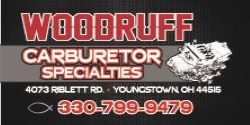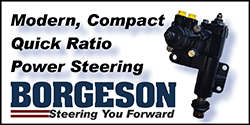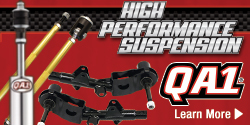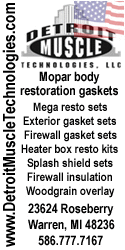The engine cannot begin to build cylinder pressure, until the intake valve closes. In a given engine,The bigger the cam intake duration, usually points to a later closing intake. The later the intake closes, the less distance the piston gets to do the compressing, and so the cylinder pressure is ever decreasing with each new later intake closing angle.And the doughier the
the bottom end gets.
The only way around this,in a given engine, is to decrease the size of the chamber that the intake-charge gets compressed into.The smaller the chamber, the higher the cylinder pressure.
All this compressing creates heat. And there comes a point that the octane rating of the fuel can no longer resist the heat, and detonation is the result. Detonation very quickly can destroy an engine and is therefore to be avoided at all costs.
Now, another upside of high cylinder pressure, is the fact that to make it,implies a good ring seal. And the good ring-seal creates a strong "suction" on the intake stroke,which at idle is very desirable. It creates a higher more stable vacuum signal to the carb, which can then be made to more accurately dispense fuel through the low-speed and cruising circuits.(which at $8/gallon is a very important thing). Furthermore the higher vacuum signal makes it easier for the A/F to be drawn into the cylinder when you whack open the throttle, and that means you can run a smaller,shorter pump-shot. This too helps economy,in traffic especially. The higher Static compression ratio, and a tight squish will agitate the A/F mixture in the chamber and distribute the gasoline better throughout it. This makes it easier to burn all of it, and thus allows a leaner mixture, and that leads to less fuel being burned, all the time.This is especially helpful at cruising speed.
Most of these pluses cannot be achieved with JUST a smaller chamber. It requires a tight squish design.
Since your compression ratio is so deep in the underground, the cheapest,most logicalest, way to get the bestest results is with the right piston design. At the price of your fuel, it logical to spend a few dollars more today, and reap the results for years to come.
Now as to your cylinder pressure question;
I think it would be very nearly impossible for most of us to predict pressures from just the Dcr numbers. I built my engine in 99, before Dcr was commonly talked about. I was like you, wanting performance with economy.At that time most everybody I talked to, hadn't even come into contact with the Dcr idea. But I had a drive to figure stuff out, and I had money enough to do this just once.So I spent a bit of time with the calculator and started to figure stuff out. But Even after understanding it, and being able to calculate it, nobody could say if this Dcr or that Dcr was supportable with such and such octane gas. I was on my own.
So I went online and found successful builds, from which I could back-calculate the Dcrs. At that time nobody was pushing the limits. I found guys were running some pretty low numbers. Some drag racers can get away with sub-optimal numbers cuz they spend very little time at rpms where this stuff matters, and they usually/often have easy access to better more detonation resistant fuel.
But for us streeters and especially for those of us using our cars as DDs in favorable weather, this stuff is VERY important.And ever more so as the price of gas rises.
So I picked a number I thought might work, and reconciled myself to the idea that I might have to run premium gas or even water-injection. Well it turns out I could have run a tad more Scr,cuz I have been burning 87E10 since day one, and the engine is happy as can be,with full timing.
So what does that mean to you?
Well, today we have empirical results from the guys out there.And almost everybody knows and understands Dcr. So much so that some very helpful people have compiled the results and created calculators. That's where I go for near instant results.You just type in your engine parameters, and in microseconds you get results.
I have still not found a calculator that definitively correlates Dcr to octane, and so you still have to rely on known combos.
Now here is a red-herring, as they say.It is well known that the higher compression numbers return more power from a given engine, and burn less fuel per horsepower doing it. So with better fuels available in NZ, this begs,for me anyway, the question; just how much compressions can a guy run on which fuel, and will it be cheaper to build one way as opposed to another. For instance, if the next grade fuel costs 5% more, can you build up the compression and go 5% further on the same amount of fuel; That would be a breakeven scenario. But what if you could go 10% further on that next grade better fuel ? Now you would be winning, and actually reducing your cost per mile. And of course the boost in compression would mean mo smoke at hammer-time! You could be the guy to figure it out. Got Cash?
So getting back to Dcrs. Here in N.America I have gleaned from this forum only, that with iron heads; 87gas will support a Dcr of about 8/1.And 89gas will support 8.25, and some are running 8.5 with 91gas. The tight squish guys are running maybe a quarter to a half a point higher, and aluminum heads seem to be good for a half a point on top of all else. So that means aluminum and tight squish might run on 91@9.25 to 9.5Dcr
I myself have successfully run 8.9 on 87E10 with aluminum and tight squish@over 185psi. I am currently running 8.7 still as above(bigger cam).
Others are running higher numbers, so it turns out, I'm kindof at the lower end. So I'm leaving performance on the table. That's ok, I already have enough tire frying capabilities.
And the next grade of fuel runs over 15% higher, and the way I drive, I could never get 15% better mileage, so I'm stuck,lol!
Well, on straight hiway, I can, but that doesn't happen very often anymore.
















